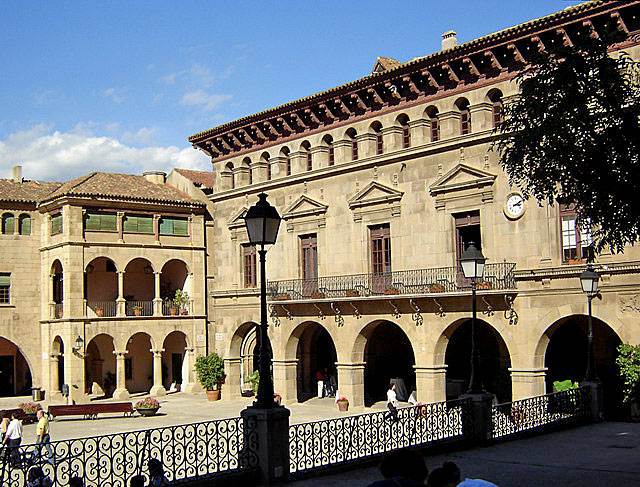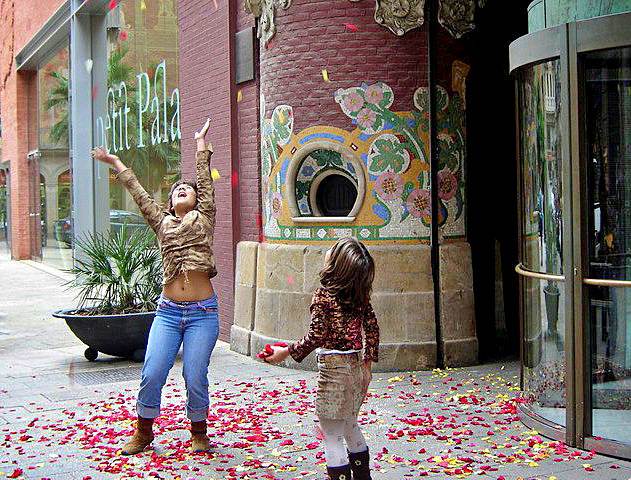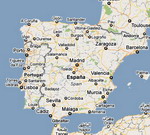Barcelona
Architecture: Like a jewel in the sun
A review on Barcelona architectural
richness dedicated to beauty, style and inspiration Barcelona is one of
the most beautiful and cosmopolitan cities in the world, while its architecture
is one of its most notable features. Historically divided into four stages,
today the architecture of Barcelona is a pleasant to the eye amalgam of
the historic heritage and modern era art. This symbiosis is so natural
and so delicate that it acts as a beautiful décor for everything
else that happens in this vibrant city no matter if that being sports events,
important modern art exhibitions, big concerts of mega starts or the simple
everyday life of the locals and the city guests.
The first of the four stages
is presented by remnants of Roman city walls and the Placa de Sant Jaume.
The second stage refers to the medieval times and results in the Gothic
quarter in the city, Placa del Rei, the beautiful cathedral and the countless
churches. Here should be mentioned carrer Montcada and Hospital de la Santa
Creau that are set outside the Gothic Quarter.
The architecture era that
followed in Barcelona was that of the Eixample construction and Modernism.
During this period the architecture flourished and some of the finest buildings
were constructed, most of them to be treated as major landmarks and tourists
attractions today. These buildings include the University and the Opera
House, Placa Reial and the formation of the new town or the so called Eixample.
It was during that period that the world famous architecture Antoni Gaudi
lived and worked. Some of his finest pieces of architecture include the
breathtaking Park Guell, the amazing Casa Mila-La Pedrera and the Casa
Vicenc, and the inspiring yet unfinished La Sagrada Familia. All of Gaudis
works are truly amazing and should be included in the sightseeing program
during a trip to Barcelona.
The present day era in Barcelonas
architecture started with the Universal Exhibition which was held in 1929.
Constructed during that period are the buildings close to Placa dEspanya
like the Platau Nacional and Poble Espanyol, for example. After that period
many new residential areas were built in Barcelona, campuses and a major
Olympics centre. Barcelona is a lively city with Mediterranean atmosphere,
full of character, space and light. Here existing with style and perfection
is a way of living.
All tourists planning a trip
to Barcelona who wish to sense that spirit are welcome to stay in one of
the numerous Barcelona Hotels, which come fantastically decorated with
locations which deserve admiration. "Barcelona - Like a jewel in
the sun", phrase from the song Barcelona performed by Freddie Mercury and
Monserat Caballe.
Top
|
Most
Popular Places in Barcelona
Everyone wants to visit a place
which is very peaceful, relaxing and fascinating but this is really a tough
job to find such place. You will really please to know that Barcelona vacation
is a place you are searching for. This city is one of the most popular
cities of Europe of today. It is located on the Mediterranean coast. This
city is really a collection of multi-faceted and diverse cities. It also
consists of 68 municipal parks, the largest of which is Montjuic, situated
on the hill of the same name and is home to some fine museums and leisure
attractions. The tourists or visitor unfamiliar with its history might
be surprised that such a modern and enterprising city preserves its historic
Gothic center almost intact, or by the curious contrast between the maze
of narrow streets and the grid-like layout of the Eixample, the urban planning
"Enlargement" project of the end of the 19th century.
This stunning city called
"Barcelona" has numerous places to visit, activities for people of all
ages, and fun for every taste after dark. It offers us array of after dark
venues ranging from inexpensive tasces (taverns) or pubs & cafes, old-fashioned
dance halls, vaudeville theatres, movie houses, shops to posh clubs, big
avenues, bars, restaurants, concerts, live shows, etc. The city certainly
has plenty of places to eat, drink and get merry late night.
Ciutat Vella has some
nice
after dark venues, such as Les Rambles, Barri Gòtic, and El Raval.
Popularly known as La Ramblas, Les Rambles is the popular boulevard running
down the center of the Ciutat Vella, dividing the Raval and Barri Gòtic,
which is the centre of the old city of Barcelona. Les Rambles and Barri
Gòtic are the major tourist traps for tourist and newcomers. You
can find many clubs, bars and restaurants, here; some of the notables are
Jamboree, Kane Room, Fonfone, Club 13, La Veronica, Schilling, Fennelli
and Margarita Blue. El Raval is often referred to as el Barri Xinès,
or China town, famous for several fashionable restaurants, cafés,
and wide range of pubs and bars, such as Dos Trece, Ra, Rita Blue, Lupino,
Ambar and Manchester.
This city is located just
north of the city centre; L'eixample in Eixample is your place for a lot
of fine clubs, bars, restaurants and cafés, such as Buda Bar, Sweet
Cafe, and City Hall. It is also known one of Barcelona's gay villages,
and thus often nicknamed as gaixample. It has many gay-oriented establishments,
such as gay bars or pubs, nightclubs, bathhouses, restaurants, bookstores,
and other businesses. It is also famous for its remarkable avenues, such
as Passeig de Gràcia, and Avinguda Diagonal.
The Poble Espanyol (Spanish
Village) on Montjuic (Sants-Montjuïc) also has some of the nice
bars and discotheques. The illuminated fountains of Montjuic are very popular
after dark venue. The funicular ride up the Tibidabo (Serra de Collserola)
is also popular after dark. The Olympic Village in Poble Nou (Sant Martí)
is also known its good selection of bars and discotheques. You can also
find a number of bars lined up in the areas of Carrer Avinyo, Rambla del
and in the streets of El Born in La Ribera. Additionally, Barcelona beaches
have some of the nice bars the offer late night fun on beaches.

Modernist architecture in
Barcelona is marked by the works of one of the most outstanding 20th-century
architects, Antoni Gaudi. The most prominent of his creations include the
Park Guell, a garden complex on a hill remarkable for its curving lines
and beautiful mosaics, the Palau Guell with its parabolic arches, intricate
forged iron decoration and original receiving room design, La Pedrera (Casa
Mila), a building without a single straight line, more of a sculpture than
a work of architecture, with an astonishing sculptured roof, and, of course,
the Sagrada Familia, the unfinished shell of a church, something out of
this world, particularly when lit up at night.
Palau de la Musica Catalana
(the Palace of Catalan Music) is another brilliant example of Modernist
architecture in Barcelona and a UNESCO World Heritage site. The concert
hall designed by Lluis Domenech i Montaner was inaugurated in 1908. Its
stage is apse-shaped, a grand central skylight adds to the effect of the
stained-glass windows, its façade features colourful mosaic decorations
and a large sculpture of Catalan Popular Song.

Your nights in Barcelona
often turn mornings! Barcelona is the city that comes rocking after dark.
The Catalonian jewel, known for its art & architectural magnificence
during daytimes, unveils its cabaret character after dark. Barcelona becomes
dazzling after dark. The after dark fun often begins with evening strolls.
Its streets and squares start getting thronged early evening, and they
are the common places for alfresco drinking, which is pretty popular in
Barcelona. The atmosphere at bars, clubs, lounges and cafés is electrifying
after dark. Music is the real fuel of Barcelona after dark life. The nightlife
typically features all types of music including Hip-Hop, R&B, Soul,
House, Techno, Rock, Razz, Jazz, Flamenco, etc. Flamenco is not as popular
as it is in Seville and Madrid, but Jazz certainly has lots of fans in
the city. You can feel music in air and everywhere in the street, concerts,
halls, clubs and even private parties.
The evening fun usually begins
from around 6 to 8pm. The moderate clubbers enjoy in their favorite clubs
and bars from 10 to 12pm. However, the fashionable clubs open their doors
at 1am; actually, time from 11Pm to 2/3Am, is the peak time for hardcore
nightlife. If you are looking to have great after dark fun in Barcelona,
you may get started with twilight promenading along Les Rambles. During
high season nightly entertainment for young or old is of a very high standard,
a good night will be had by all.
During high season nightly
entertainment for young or old is of a very high standard, a good night
will be had by all. A bus service from the campsite entrance operates every
15 or 20 mins which takes you into the bustling Spanish town of Vilanova
i a Gelru with its many high street shops, piazza's, restaurants, bars
etc. Next to the towns marina is the most magnificent safe sandy beach
in Spain all within 1.5 km away from the Spanish campsite near Barcelona
which has a huge range of facilities and services the campsite is located
on the Costa Dorada, with good weather all year round.
Being close to Barcelona,
Tarragona, Salou, Universal Studios Port Aventura etc makes Vilanova-i-la-Geltrú
the perfect base for campsite camping holidays near Barcelona. The camping
holiday park near Barcelona and campsite Spain is situated on the outskirts
of the town in a natural park, with a wide range of animals and vegetation,
including a mini-zoo also.
Top
|
Taste
Catalan culture in Barcelona
For a short city break, Barcelona
is hard to beat. Its close proximity to the UK and the availability of
inexpensive flights makes it an ideal destination for a quick jaunt in
the sun, as well as providing some great food, drink and culture.
If you're only visiting Barcelona
during a short break, perhaps over a weekend, you'll likely find the city
can be overwhelming as there are so many things to see and do. On top of
this, you'll also need time to relax as well as sample some authentic Catalan
cuisine while and hopefully, squeeze in enough time to experience the city's
abundant nightlife. As a result, it may be worthwhile planning an extra
day or two in order to balance cultural with recreational pursuits and
maintain a relaxed pace.
To tick the culture box,
head to the Picasso museum. There is no mistaking why this is the most
visited museum in the city, as it houses some of the very early works of
the artist. Most known for his abstract works, such as his cubist style,
the early drawings and artwork on display reveals first hand the natural
talent and precision Picasso exhibited throughout his life. The museum
also houses works from his dark blue period and Las Meninas series; major
draws for art fans.
Once in the city you will
hear the distinct Spanish that is spoken there. The Spanish dialect in
Barcelona is highly influenced by Catalan, the other major language of
the region. It becomes quickly evident why the Catalan people are known
for being extremely proud of their regional identity, culture and language.
The city is clearly different from other Spanish cities in terms of the
people, architecture and culture, while for a glimpse deeper Catalan culture,
head to the Gothic Quarter and old port areas. On you way, don't miss a
stroll down the famed Las Ramblas - arguably Spain's most famous boulevard.
Although often packed with tourists, it hard to beat for people-watching,
shopping and eating.
When it comes to food, the
cuisine of Barcelona is distinct from traditional Spanish fare, despite
using similar ingredients such as garlic, olive oil and tomatoes. Catalan
cuisine also reflects the food found in other countries that lie on the
Mediterranean, such as northern Africa, and you'll likely find dishes which
include raisins, nuts, snails and meat cooked with fruit on many menus.
Although quite distinct from
the rest of Spain, Barcelona also prescribes to the same eating patterns:
a lengthy, late lunch followed by an afternoon snack and a similarly lengthy,
late dinner. If not travelling to anywhere else in Spain, having little
plates of food called 'tapas', accompanied by a pitcher of sangria is a
must.
The architecture of the city
is highly influenced by the works of Antoni Gaudi, and for a more in depth
look at his creations, a visit to La Sagrada Familia is a must. Gaudi devoted
much of his life to the building of this cathedral, where work still continues
today. The work is intricate, unique and like no other cathedral ever visited.
A Barcelona city break is
perfect for a quick getaway. Accommodation ranges from impossibly cheap
to five star hotels. Any taste can be suited for and any whim practically
guaranteed from this Spanish city. The prevalence of flights leaving from
Britain also makes Barcelona an easily managed destination - especially
if you are keen to brush up on your Spanish.
Top
|





